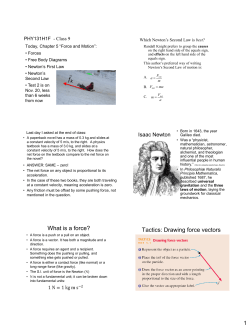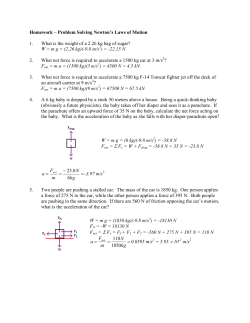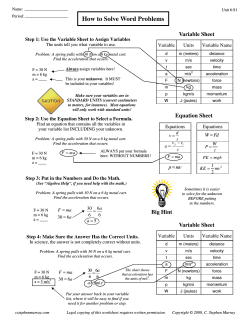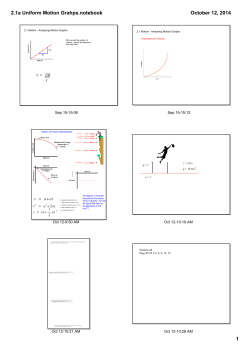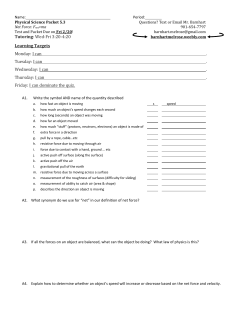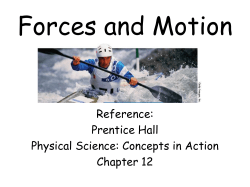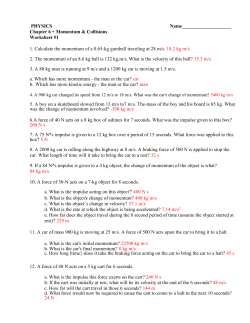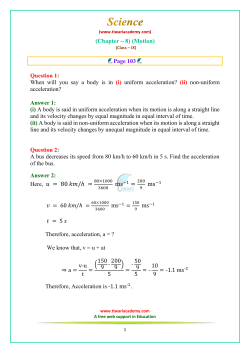
Key to Dynamics Review package
Force Of Gravity Do your work on your own sheets of paper. Notes: 1 t = 1 tonne = 1000 kg g = 9.80 N/kg G = 6.67 x 10-11 Nm2/kg2 mass of Earth = 5.98 x 1024 kg radius of Earth = 6.38 x 106 m 1. What is the force of gravity at the Earth 's surface on each of the following masses? (a) 75.0 kg 735 N (b) 454 g 4.45 N (c) 2.00 t 19 600 N (d) 3.14 kg 30.8 N 2. What is the force of gravity on each of the following masses? (a) 25 g 0.25 N (b) 102 kg 1.00 x 103 N (c) 12 mg 1. 2 x 10-4 N 0.382 kg 3.74 N (d) 3. Use these forces of gravity to determine the masses of the objects on which they act. (a) 0.98 N 0.10 kg (b) 100 N 10.2 kg (c) 62 N 6.3 kg (d) 44.5 6 MN 4.54 x 10 kg 4. Calculate the gravitational field strength at the surface of each of the following planets: Planet Mass on planet’s Surface (kg) Force of gravity on this mass (N) g (N/kg) Mercury 57 201 3.5 Venus 29 247 8.5 Earth 83 813 9.8 Mars 453 1688 3.72 Pluto 82 656 8.0 5. Why is the gravitational field strength half way up Mount Everest the same as at sea level where g= 9.80 N/kg? The distance from the center of the earth to that point is not very much different than the distance to the center of earth alone (radius of the earth is 6.38 x 106 m while Everest itself is 8850 m … now add half of this height to the radius of the Earth, you get 6.38 x 106 m rounded to three sig. figs.). Since the height does not add much to the radius value in Newton’s Law of Universal Gravitation, the value of g does not change significantly. At the top of Everest, along with more precision in the values used, the value of the gravitational field strength is 9.77 N/kg. Another interesting note is that since the Earth is not exactly spherical (its radius is larger through the equatorial plane compared to between the poles), the g value at the equator is less than that at the poles (not much different but measurable). 6. Why is the gravitational field strength at the South Pole less than the field strength at the North Pole? Yes, since the Antarctic is actually a continent not just a large sheet of ice and the South Pole has an elevation of 3700 m … the North Pole is at sea level (just ice flows up there!!). Since the South Pole is farther from the center of the Earth it must have a lower gravitational field strength. 7. The force of gravity on an astronaut is 600 N at the Earth’s surface. (her mass must be 61.2 kg) What is the force of gravity on her at each of the following distances from the centre of the Earth, measured in multiples of the Earth's radius? (a) 2 150 N (b) 5 24 N (c) 10 6 N (d) 20 1.5 N 8. The force of gravity on a spacecraft some distance from the Earth is 800 N. What would that force be if its distance to the Earth's centre were: (a) one-half as great? 4 times greater, 3200 N (b) one-third as great? 9 times greater, 7200 N (c) one-tenth as great?100 times greater, 8000 N (d) onequarter as great?16 times greater, 12800 N 9. A 20. kg object out in space is attracted to the Earth by a force of gravity of 100 N. How fast will the object accelerate towards the Earth, if it is falling freely? 5.0 m/s2 10. Two of the largest oil tankers in the world, the Batilus and the Bellaya, have masses of 492 000 tonne fully loaded. If they were moored side-by-side, l.0 m apart, their centres would be 64 m apart. Calculate the force of gravity between them. 3940 N 11. Sirius is the brightest star in the night sky. It has a radius of 2.5 x 109 m and a mass of 5.0 x 1031 kg. What is the gravitational force on a 1.0 kg mass at its surface? 534 N 12. Sirius B is a white dwarf star, in orbit around Sirius, with a mass of 2.0 x 1030 kg (approximately the mass of the sun), and a radius of 2.4 x l07 m (approximately onethirtieth of the radius of the sun). (a) What is the force acting on a l.0 kg mass on the surface of Sirius B? 2.3 x 105 N (b) What is the acceleration due to gravity on the surface of Sirius B? 2.3 x 105 m/s2 13. A l000 kg communications satellite in synchronous orbit 42 400 km from the Earth's centre has a period of 24 h. Placed in orbit above the equator, and moving in the same direction as the Earth is turning, it stays above the same point on the Earth at all times. This makes it useful for the reception and retransmission of telephone, radio, and TV signals. (a) Calculate the force of gravity acting on the satellite. 222 N(b) What is the gravitational field strength at this altitude? 0.222 N/kg Newton’s Universal Law of Gravitation 1. Determine the force of gravity between the Sun (Mass of Sun = 1.98 x 1030 kg) and the Earth (Mass of earth = 5.98 x 1024 kg). The distance between the sun and Earth’s centers is 1.50 x 1011 m. 3.51 x 1022 N 2. What is the force of gravity between two 250 kg sumo wrestlers that are 2.0 m apart? 1.04 x 10-6 N 3. What is meant by a mutual force of attraction? Each object attracts the other at the same time 4. What is the distance between two 20.0 kg objects that have a mutual force of gravitational attraction of 3.0 x 10-7 N? 0.30 m 5. The force of gravity on a black bear is 2500 N on the earth’s surface. The animal becomes so ‘unbearable’ that it is transported four earth radii from the surface of the earth. What is the force of gravity on it now? 100 N 6. What is the mass of a planet with a radius of 4.5 x 105 m that displays a force of gravity of 34 N on an 8.0 kg object at its surface? 1.29 x 1022 kg 7. Given two small, chocolate-centered candies of masses M and m, what will happen to the force of gravity between them if a) d (the distance between them) is doubled? force is one-fourth of original b) d is tripled? force is one-ninth of original c) d is reduced by one half? force is increased by a factor of 4 d) d is reduced by one third? force is increased by a factor of 9 8. What is the radius of a planet with a mass of 7.9 x 1027 kg that displays a force of gravity of 64 N on a 6.0 kg object at its surface? 2.22 x 108 m 9. What is the gravitational field strength of a planet with a mass of 7.9 x 1027 kg and radius of 3.2 x 106 m? 5.15 x 104 N/kg 10. Given two candies with masses M and m, a distance d apart, what will the force of gravity become is a) only M is doubled? force is doubled b) only m is doubled? force is doubled c) both M and m are doubled? force is quadrupled d) M, m and d are all doubled? force is the same 11. The constant G in the Law of Universal Gravitation has a value of 6.67 x 1011 Nm2/kg2. Calculate the force of gravity between: a) a 100.0 kg person and the earth (Mass of earth = 5.98 x 1024 kg, Radius of earth = 6.38 x 106 m) 980 N b) a 100.0 kg person and the moon (Mass of moon = 7.35 x 1022 kg, Radius of moon = 1.74 x 106 m) 162 N c) two 46 g golf balls whose centers of mass are 10 cm apart (Hint: Always change your units to International Standards i.e. kg and meters) 1.41 x 10-11 N Newton’s Second Law The kinematics equations will often apply, but the foundation of these problems will be Newton’s Second Law. All forces considered must be treated as one-dimensional vector quantities. Therefore, forces pointing in the positive direction of the coordinate system will have a +ve sign, and those pointing in the negative direction will have a -ve sign. 1. If an object is at rest, can we conclude that there are no external forces acting on it? No, there may be balanced forces acting in many directions. 2. The force of gravity is twice as great on a 20. N rock as it is on a 10. N rock. Why doesn’t the 20. N rock have greater free-fall acceleration? Even though a greater net force is acting on the 20. N rock, it has a mass twice as large. Therefore, the acceleration is the same for both. 3. A certain particle has a weight of 22 N at a point where the free-fall acceleration is 9.80 m/s2. (mass is 2.24 kg) (a) What are the weight and mass of the particle at a point where the free-fall acceleration is 4.9 m/s2? (mass is 2.24 kg, weight is 11 N) (b) What are the weight and mass of the particle if it is moved to a point in space where the free-fall acceleration is zero? (mass is 2.24 kg, weight is 0 N) 4. What is the mass of an astronaut whose weight on the moon is 115 N? The acceleration due to gravity on the moon is 1.63 m/s2. 70.6 kg 5. When an airplane is in level flight, its weight is balanced by a vertical “lift” which is a force exerted by the air. How large is the lift on an airplane in such flight if its mass is 1.20 x 105 kg? 1.18 x 106 N 6. On a hypothetical planet, the acceleration due to gravity at its surface is 0.072 times that of g on earth (0.706 m/s2). If an object weighs 25 N on earth, what will it weigh on the surface of the hypothetical planet? 2.55 kg, 1.80 N 7. An experimental rocket sled can be accelerated at constant rate from rest to 1600 km/h (convert this to 444.4 m/s) in 1.8 s. What is the magnitude of the required average force if the sled has a mass of 550 kg? Calculate acceleration first using kinematics; a = 247 m/s2. Then calculate F using Newton’s second law; F = 136 000 N 8. A jet plane starts from rest on a runway and accelerates for takeoff at 2.3 m/s2. It has two jet engines, each of which exerts a force on the plane (thrust) of 1.4 x 104 N. What is the weight of the plane? 12 200 kg is the mass, 2.8 x 104 N is the weight (recall that weight is the force of gravity on the object) 9. In a modified tug-of-war game, two people pull in opposite directions, not on a rope, but on a 25 kg sled resting on an icy road (don’t worry, their boots have the amazing ability not to slip at all on ice). If the participants exert forces of 93 N and 97 N, what will be the magnitude of the sled’s acceleration? 4 N of force will 0.16 m/s2. 10. A 5.0 g bullet leaves the muzzle of a rifle with a speed of 320 m/s. What average force is exerted on the bullet while it is traveling down the 0.82 m long barrel of the rifle? a = 62 440 m/s2, F = 312 N 11. An electron travels in a straight line from the cathode of a vacuum tube to the anode, which are exactly 1.5 cm apart. It starts from rest and reaches the anode with a speed of 6.0 x 106 m/s. (a) Assuming constant acceleration 1.2 x 1015 m/s2, calculate the magnitude of the force (which happens to be the electrical force) on the electron. 1.09 x 10-15 N The electron’s mass is 9.11 x 10-31 kg. (b) Calculate the weight of the electron. 8.93 x 10-30 N 12. A cinder block of mass 15 kg is suspended from a rope. Calculate the tension on the rope. 147 N Force of Friction 1. a) Where on a bicycle do you want to reduce friction? How is this done? Axels with grease b) Where on a bicycle do you want friction? Tires on the road, brakes 2. a) What is meant by the coefficient of kinetic friction? Ratio of frictional force to normal force (or force of gravity) which represents a relative amount of roughness for 2 surfaces rubbing against each other b) Why is there no units attached to values of µ? It is a ratio! Therefore, no units. c) A force of 120 N is needed to push a box along a road at a steady speed. If the force of gravity on the box is 250 N, what is the coefficient of kinetic friction between the box and the road? Ffr = µFN µ = Ffr ÷ Fg since FN = Fg µ = 120 N ÷ 250 N = 0.48 3. The coefficient of kinetic friction between a steel block and an ice rink surface is 0.0100. If a force of 24.5 N keeps the steel block moving at steady speed, what is the force of gravity on the block? Ffr = µFN FN = Fg = Ffr ÷ µ FN = 24.5 N ÷ 0.0100 = 2450 N 4. A boy exerts a 36.0 N horizontal force as he pulls a 52.0 N sled across a cement sidewalk at constant speed. What is the coefficient of kinetic friction between the sidewalk and the metal sled runners? Ignore air resistance. Ffr = µFN µ = Ffr ÷ Fg since FN = Fg µ = 36.0 N ÷ 52.0 N = 0.692 5. Suppose the sled from question 4 now runs on packed snow. The coefficient of friction is now only 0.12. If a person weighing 650.0 N sits on the sled, what force is needed to pull the sled across the snow at constant speed? There is no net force Ffr = µFN Ffr = µFg Ffr = (0.12)(702 N) remember the person sitting on the sled! Ffr = 84.0 N 6. The coefficient of friction between two surfaces is 0.34. If a person experiences a force of friction of 540 N, what is their weight? person sitting on the sled! Ffr = µFN Ffr = µFg 540 = (0.34) Fg remember the Fg = 1590 N Newton’s Second Law Calculations 1. A towrope is used to pull a 1750 kg car giving it an acceleration of 1.35 m/s2. What force does the rope exert? 2360 N 2. A racing car undergoes a uniform acceleration of 4.00 m/s2. If the net force causing the acceleration is 3.00 x 103 N what is the mass of the car? 750 kg 3. A 5.2 kg bowling ball is accelerated from rest to a velocity of 12.0 m/s as the bowler covers 5.0 m of approach before releasing the ball. What force is exerted on the ball during this time? a = 14.4 m/s2; F = 74.9 N 4. A high jumper, falling at 4.0 m/s, lands on a foam pit and comes to rest, compressing the pit 0.400 m. If the pit is able to exert an average force of 1200 N on the high jumper in breaking the fall, what is the jumper's mass? a = -20. m/s2; m = 60. kg 5. On Planet X, a 50.0 kg barbell can be lifted by exerting a force of only 180 N. a) What is the acceleration of gravity on Planet X? 3.6 m/s2 b) If the same barbell is lifted on Earth what minimal force is needed? F = 490 N 6. A proton has a mass of 1.672 x 10-27 kg. What is its weight? F = 1.639 x 10-26 N 7. A force of 20.0 N accelerates a 9.00 kg wagon at 2.0 m/s2 along the sidewalk. a) How large is the frictional force? 2.0 N b) What is the coefficient of friction? 0.023 8. A 2.00 kg brick has a sliding coefficient (kinetic coefficient) of friction of 0.38. What force must be applied to the brick for it to move at a constant velocity? Fnet = 0 N; Fapp = 7.45 N (just enough to overcome friction) 9. In bench-pressing 100. kg a weight lifter applies a force of 1040 N. How large is the upward acceleration of the weights during the lift? Fnet = Fapp – Fg therefore Fnet = 60. N and a = 0.60 m/s2 10. An elevator that weighs 3.0 x 103 N (mass is 306 kg) is accelerated upward at 1.0 m/s2. What force does the cable exert to give it this acceleration? Fnet = FT – Fg therefore FT = ma + Fg = 3.31 x 103 N 11. A person weighing 490 N (mass is 50. kg) stands on a scale in an elevator. a) What does the scale read when the elevator is at rest? 490 N (Fg = FN the normal force is actually measured by the scale!) b) What is the reading on the scale when the elevator rises at a constant velocity? 490 N (a = 0 m/s2) c) The elevator slows down at –2.20 m/s2 as it reaches the desired floor. What does the scale read? From experience, you may know that when an elevator goes downward we feel a little bit of weightlessness. Here Fnet = FN - Fg by defining up as positive and down as negative. Since Fnet is –110 N (mass of 50. kg times –2.20 m/s2), we can rearrange the above to find that the normal force is 380 N and the person weighs less. You could do this by subtracting the g – a (9.80 – 2.20 m/s2) and then multiplying by the mass. d) The elevator descends accelerating at –2.70 m/s2. What does the scale read? Same as above but with a larger downward acceleration so FN = 355 N. e) What does the scale read when the elevator descends at a constant velocity? 490 N (a = 0 m/s2) f) Suppose the cable snapped and the elevator fell freely. What would the scale read? Here Fnet = FN - Fg by defining up as positive and down as negative. Since Fnet is –490 N (mass of 50. kg times –9.80 m/s2), we can rearrange the above to find that the normal force is 0 N and the person weighs nothing. g) What does the scale read if the elevator was to accelerate upwards at 1.0 m/s2? From experience, you may know that when an elevator goes upwards we feel a little bit of extra force downward on us. Here Fnet = FN - Fg by defining up as positive and down as negative. Since Fnet is +50. N (mass of 50. kg times +1.0 m/s2), we can rearrange the above to find that the normal force is 540 N and the person weighs more. You could do this by adding the g + a (9.80 + 1.0 m/s2) and then multiplying by the mass. 12. When a 20.0 kg child steps off a 3.0 kg stationary skateboard with an acceleration of 0.50 m/s2, with what acceleration will the skateboard travel in the opposite direction? The force that child exerts on the skateboard is 10. N, so there is an equal but opposite force of 10. N on the skateboard. It is pushed away at 3.3 m/s2. 13. Given the following diagrams determine the Fnet and the acceleration of the system. Then find the tension in each cable that connects the masses. Consider the pulleys and tabletops to be frictionless. a) b) Fnet on system = Fg on 2.5 – FT + FT – Fg on 1.0 F net on system = Fg of 1.0 kg – FT + FT Fnet = Fg on 2.5 – Fg on 1.0 Fnet = Fg og 1.0 kg msystema = m2.5g – m1.0g (3.5 kg)a = (2.5 kg)(9.80 m/s2) – (1.0 kg)(9.80 m/s2) msystema = mg a = 4.2 m/s2 a = 2.8 m/s2 (3.5 kg)a = (1.0 kg)(9.80 m/s2) Friction and Elastic Forces 1. A 20.0 kg toboggan is pulled along by a force of 30.0 N (a) What is the force of gravity on the toboggan? 196 N (b) What is the coefficient of friction? 0.153 (c) How much force is needed to pull the toboggan if two 60.0 kg girls are sitting on it? 140.0 kg, therefore 206 N 2. It takes a 5.0 N force to pull a 2.0 kg object along the ground. What is the coefficient of friction? 0.26 3. How much force does it take to pull a 100.0 kg (980.0 N) packing crate along a rough floor, given each of the following coefficient of friction? (a) 0.10 98 N (b) 0.20 196 N (c) 0.50 490 N (d) 0.90 882 N 4. lf the coefficient of friction is 0.25, how much force is needed to pull each of the following masses along a rough desk? (a) 25 kg (weight is 245 N) 61 N (b) 5.0 kg (weight is 49 N) 12 N (c) 200. g (weight is 1.96 N) 0.49 N (d) 3.5 t (weight is 34 300 N) 8600 N (to 2 s.f.) 5. A 10.0 N force stretches a length of fishing line by 10.0 cm. What is the line’s spring constant? 100 N/m 6. A 20.0 N force is used to stretch various rubber bands. Calculate the amount of stretch that will occur, given each of the following spring constant. (a) 200. N/m 0.100 m (b) 100. N/m 0.200 m (c) 400. N/m 0.0500 m (d) 750. N/m 0.0267 m 7. An archer pulls back with a force of 240. N, moving the arrow 60.0 cm. What is the spring constant of the bow? 400. N/m 8. Find the unbalanced force for each of the following combinations of forces. (a) 20. N [E], 30. N [W], 50. N [E] Fnet = 40 N [E] (b) 27.3 N [N], 2.8 N [S], 13.5 N [S] Fnet = 11 N [N] (c) 50. N [E], 20. N [W], 5. N [E], 35 N [W] Fnet = 0 N The Tension Challenge Draw FBDs for all problems! 1. A 550 kg elevator is at rest and is being held by a cable. Determine the tension forces in the cable. Fnet = Fg - FT 0 = mg - FT since it not accelerating Fnet is zero FT = mg FT = (550)(9.80) = 5390 N 2. A 25 kg sign hangs outside a restaurant and is being held by two cables. Determine the tension forces in each cable. (hint: the weight is distributed evenly between the two cables!) Fnet = Fg - FT 0 = mg - FT since it not accelerating Fnet is zero FT = mg FT = (25)(9.80) = 245 N (divide this by 2 to find Tension in one cable) FT = 123 N 3. A 12.0 kg bucket is lifted upwards with constant velocity by a rope. What is the tension in the rope? Fnet = FT – Fg 0 = FT - mg since bucket is not accelerating Fnet is zero FT = mg FT = (12)(9.80) = 118 N 4. A 12.0 kg bucket is accelerated upwards at 0.60 m/s2 by pulling a rope. What is the tension in the rope? Fnet = FT – Fg ma = FT - mg since bucket is accelerating Fnet is included (12)(0.60) = FT - (12)(9.80) FT = 125 N (note that there is more tension in the rope as the bucket is pulled upwards!) 5. A 12.0 kg bucket held by a rope is accelerated downwards at 0.80 m/s2. What is the tension in the rope? Fnet = Fg – FT ma = mg - FT since bucket is accelerating Fnet is included (12)(0.80) = (12)(9.80) - FT FT = 108 N (note that there is less tension in the rope as the bucket is dropped downwards!) 6. A 30.0 kg block is pulled along a table surface by a rope. If the table surface has a µ = 0.18, what applied force (the tension force) in the rope necessary to accelerate the block at 1.5 m/s2? Fnet = FT – Ffr ma = FT – µFN since block is accelerating Fnet is not zero! (30)(1.5) = FT - µmg (30)(1.5) = FT – (0.18)(30.0)(9.80) FT = 98N 7. A 20.0 kg block is pulled along a table surface by a rope. If the table surface has a µ = 0.10, what applied force (the tension force) in the rope necessary to accelerate the block at 2.5 m/s2? Fnet = FT – Ffr ma = FT – µFN since block is accelerating Fnet is not zero! (20)(2.5) = FT - µmg (20)(2.5) = FT – (0.10)(20.0)(9.80) FT = 70 N 8. Two buckets are at rest as arranged in the diagram below. Determine the tension in each rope. Rope #1 10 kg Rope #2 20 kg Fnet = FT – Fg the FT of the other rope cancels out! 0 = FT - mg10 – mg20 since bucket is not accelerating Fnet is zero FT = mg10 + mg20 FT = (10)(9.80) + (20)(9.80) = 294 N Fnet = FTrope 1 – mg10 - FTrope 2 0 = 294 - (10)(9.80) - FTrope 2 FTrope 2 = 196 N 9. What is the tension in the rope that joins the two blocks that are pulled by a constant force of 500 N in the diagram below: 10 kg 20 kg µ = 0.12 Fnetsys = Fapp – Ffr20 – FT + FT – Ffr10 msysa = Fapp – Ffr20 – Ffr10 since block is accelerating Fnet is not zero! (30)(a) = Fapp - µm20g - µm10g (30)(a) = 500 – (0.12)(20.0)(9.80) – (0.12)(10.0)(9.80) a = 15.5 m/s2 Fnet10 = FT – Ffr10 m10a = FT – Ffr10 since block is accelerating Fnet is not zero! (10)(15.5) = FT - µm10g 155 = FT - (0.12)(10.0)(9.80) FT = 167 N 10. Safety engineers estimate that an elevator can hold 15 persons of 80 kg average mass. The elevator itself has a mass of 500 kg. Tensile strengths show that the cable supporting the elevator can withstand a maximum force of 2.85 x 104 N. What is the greatest acceleration that the elevator can attain without breaking the cable? accelerated the object upwards, we should consider this when constructing our FBD. We should use FT = 2.85 x 104 N Fnet = FT – Fg ma = FT - mg total mass is 1700 kg (15 x 80 + 500) (1700)(a) = 2.85 x 104 – (1700)(9.80) a = 6.96 m/s2 Momentum Problems Momentum/Impulse Formulas: Law of Conservation of Momentum: pbefore = pafter With two objects that collide and separate With two objects that collide and stick together Problem Solving Tactics for Momentum/Impulse: 1. Draw TWO diagrams: a BEFORE & an AFTER the event (e.g. collision) -Be sure to choose a positive and negative directions... the velocities need to be expressed with the appropriate direction! In each, label which object is m1, m2, etc. 2. Set up an equation that take the TOTAL MOMENTUM BEFORE the collision and makes it equal to the TOTAL MOMENTUM AFTER the collision. ...Solve for the unknown Problems: 1. Two train cars approach each other, one of mass 113 000 kg traveling at 1.20 m/s, the other of mass 75 000 kg traveling at 2.30 m/s. After the collision, the two cars lock together. (a) What is the momentum of the heavier car? 136 000 kg•m/s (b) What is the momentum of the lighter car? 173 000 kg•m/s (c) What is the total momentum of the cars before the collision? 36 900 kg•m/s (172500-135600 – using unrounded values) (d) What is the total momentum of the cars after the collision? 36 900 kg•m/s (e) What is the velocity of the cars after the collision? 0.20 m/s 2. Two billiard balls, each of mass 565 g, approach each other, one with speed of 2.3 m/s and the other with a speed of 4.5 m/s. After the collision, the one that was traveling faster reverses its direction and travels at 2.3 m/s. What is the velocity of the other ball? 4.5 m/s in the opposite direction 3. A child’s ball of mass 560 g rolls along the ground at 7.6 m/s towards a stationary bowling ball of mass 4.5 kg. After the collision, the bowling ball travels at 1.5 m/s. What is the velocity of the child’s ball? -4.45 m/s 4. Two train cars approach each other, one mass 76 000 kg traveling at 3.5 m/s, the other of mass 95000 kg traveling at 1.9 m/s. They are expected to lock together, but instead they bounce off each other, the lighter one reversing its direction and traveling with a speed of 0.42 m/s. What is the velocity of the other car? 1.24 m/s opposite to its original direction 5. A car of mass 1500 kg traveling at 15.6 m/s loses its brakes and collides with the rear end of the car in front of it, which has a mass of 1020 kg and is traveling in the same direction at 12.5 m/s. If the smaller car is given a speed of 15.3 m/s by the collision, what is the speed of the larger car after the collision? 13.7 m/s in the original direction 6. A tennis ball may leave the racket of a top player on the serve with a speed of 65.0 m/s. The ball’s mass is 0.0600 kg and it is in contact with the racket for 0.0300 s. (a) What is the impulse on the ball?Original momentum is zero, therefore the change in momentum is pfinal –pinitial or 3.9 N•s – 0 N•s = 3.9 N•s (b) What is the force on the ball? Use F = Δp/Δt= 130 N 7. A 0.145 kg baseball pitched at 39.0 m/s is hit on a horizontal line drive straight back toward the pitcher at 52.0 m/s. If the contact time between bat and ball is 0.00100 s, calculate the impulse on the ball and the force between the ball and bat during contact. Impulse is 13.2 N•s and force = 13 200 N Momentum And Impulse 1. An object is pushed with a force of 6.0 N for 0.50 s. What impulse is given to it? 3.0 kg•m/s 2. What impulse produces a velocity change of 4.00 m/s in a 12.5 kg mass? Δp=pfinal – pinitial = mΔv = 50.0 N•s 3. A 15.0 kg wagon is accelerated by a constant force of 60.0 N from 5.00 m/s to 13.00 m/s. (a) What impulse does the wagon receive? 120 N•s (b) For how long was the force acting on the wagon? 2.0 s 4. A freight car with a mass of 6.0 x 104 kg is rolling along a level track at 0.40 m/s, dragging a chain behind it. (a) If the largest force that could be applied to the chain is 320.0 N, how long would it take to stop the car? Δt = Δp/F = 75 seconds (b) How far would the car move before it could be stopped? Use kinematics equation, acceleration is -‐5.33 x 10-‐3 m/s2, therefore, 15.0 m 5. What average force will stop a hammer with a momentum of 48.0 N•s in 0.030 s? 1600 N 6. A stone of mass 10.0 kg slides along the ice in a straight line with a constant velocity of 8.00 m/s. A constant force then acts on the stone for 2.50 s, changing its velocity to 2.00 m/s. (a) What is the momentum of the stone before and after the force acts? Before is 80.0 kg•m/s while after is 20.0 kg•m/s (b) Calculate the impulse acting on the stone. Δp = 60.0 kg•m/s (c) What is the magnitude and direction of the force that is acting? The force is 24.0 N opposing the original motion (and momentum). 7. Two frictionless discs on an air table, initially at rest, are drive apart by an explosion with velocities of 9.0 m/s and 5.0 m/s. What is the ratio of their masses? pinitial is zero, after explosion masses go in opposite directions and have MUST have equal but oppositely directed momenta. The masses have to be in a 5:9 ratio in order to make the momenta equal. Best way to see this is as m2=5/9m1. 8. Two dynamic carts are at rest with a compressed spring between them. When the spring is allowed to expand, the carts move apart. Both hit bricks at either end of the table, simultaneously, but cart A moves 0.60 m while cart B moves 0.90 m. What is the ratio of: (a) the speed of A to the speed of B after the expansion of the spring? Cart B must be moving faster since it went a further distance in the same amount of time as cart A. The ratio is 3:2. Best way to see this is as m2=3/2m1. (b) their masses? Since each cart acquired the same momentum (equal but opposite since there was initially zero momentum), the ratio of the masses of the carts is 3:2 (Cart A: Cart B). Cart A is more massive than B, noted by the fact that cart A moves a smaller distance and has lees speed (but same momentum). (c) the impulses applied to the carts? The impulses (read this as the change in momentum or Δp) would have to be equal. (d) the acceleration of the carts while the spring was pushing them apart? Since acceleration is the change in velocity over time, Cart B must have greater acceleration … again in a 3:2 ratio. 9. A proton of mass 1.67 x 10-‐27 kg, traveling with a speed of 1.0 x 107 m/s, collides with a helium nucleus at rest. The proton rebounds straight back with a speed of 6.0 x 106 m/s while the helium nucleus moves forward with a speed of 4.0 x 106 m/s. (a) What was the total momentum before the collision? 1.67 x 10-‐ 20 kg•m/s (b) What was the momentum of the proton after the collision? 1.00 x 10-‐20 kg•m/s in opposite direction! (c) What was the momentum of the helium nucleus after the collision? 2.67 x 10-‐20 kg•m/s (d) Determine the mass of the helium nucleus. 6.68 x 10-‐27 kg 10. A stationary flatcar of mass 4.0 x 104 kg is rammed by a locomotive with a mass of 6.0 x 104 kg and a velocity of 4.5 m/s. If they stick together, with what velocity will they continue to move? 2.7 m/s 11. Two 2.5 kg carts are moving along together with a velocity of 2.0 m/s when a spring compressed between them expands rapidly. The front cart continues with a velocity of 3.0 m/s, in the same direction. (a) What was the momentum of the two carts before the explosion? 10. kg•m/s (b) What was the momentum of the front cart after the explosion? 7.5 kg•m/s (c) What was the velocity of the second cart after the explosion? 1.0 m/s (d) What velocity would the front cart have had to acquire for the second cart to remain stationary after the explosion? 4.0 m/s 12. A 1.5 kg brick is dropped vertically onto a 2.5 kg toy truck, which is moving across a level floor at 0.80 m/s. With what velocity do the truck and brick continue to move, after the brick has landed on the truck? 0.50 m/s 13. Explain how an astronaut who is stranded in free space a short distance from his spacecraft might employ his knowledge of momentum to return safely to the craft. Why must he be very careful about his momentum? He or she may have to throw something away from themself (directly away from the direction that they would like to head) in order to gain momentum towards the spacecraft. The astronaut must be careful since, without the effects of gravity and/or something to grab onto, he/she could find themselves carrying on in a straight line forever – the astronaut must make sure that their momentum is lines up correctly in order not to miss the shuttlecraft! 14. A sandbag is mounted on a cart that is at rest on a horizontal frictionless surface, and their total mass is 4.5 kg. What will be the velocity of the cart and sandbag if a bullet of mass 2.0 g is fired into the sandbag with a horizontal velocity of 500. m/s? The p of the bullet is 1.0 N•s. This will be transferred to the sandbag etc (note that the bullet’s mass is too small to worry about in comparison to the other masses). The momentum of the sandbag etc will now be 1.0 N•s, which gives it a velocity of 0.22 m/s. 15. Two boys of mass 45 kg and 60 kg, respectively, are sitting on two separate 15 kg wagons, facing each other and holding a rope taut between them. The lighter boy pulls on the rope and acquires a velocity of 2.0 m/s. What is the velocity of the other boy? 1.6 m/s towards the lighter boy. Dynamics Review Practice Universal Gravitation 1. What is the strength of the gravitational field (in N/kg) at an orbit of 1.0 x106 m above the planet Zoklopgniald with mass of 3.45 x1026 kg and mean radius of 7.80 x107m? 3.69 N/kg What is the gravitational force exerted on a 2840 kg satellite orbiting Zoklopgniald at this altitude? 10 500 N 2. What is the force of gravity between two electrons (mass = 9.11 x 10-31 kg) that are 1.0 m apart? 5.54 x 10-71 N 3. What is the strength of the gravitational field 10.0 metres away from your body? About 5.0 x 10-11 N/kg Frictional Forces 1. A sled is being pulled to the right with a force of 28 N. A frictional force is working opposite the applied force with a magnitude of 17 N. The mass of the sled is 4.5 kg. (a) What is the net force in the x direction? 28 – 17 = 11 N (b) What is the coefficient of friction between the sled’s blades and the surface? µ = 0.385 2. A football player with a mass of 86 kg, dives into the end zone and is slowed by the grass after he hits the ground by a force of friction of 580 N. What is µ between the player and the grass? µ = 0.69 3. A person pushes horizontally with a force of 350 N on a 68 kg chair to move it across a level floor. The coefficient of friction is 0.37. (a) What is the magnitude of the frictional force? 247 N (b) What is the acceleration of the chair? Fnet = 350 – 247 = 103 N, acceleration = 1.51 m/s2 Elastic Forces 1. A spring mechanism at the end of a cart has a k = 480 N/cm. The cart, on the spring side, is held up against the wall, causing a distortion on the spring of 3.8 cm. (a) Calculate the restoring force of the spring.1824 N (b) If the cart has a mass of 1.050 kg, what will its acceleration be on the frictionless surface? Felastic=Fnet therefore 1737 m/s2 2. A certain spring, hanging vertically, is distorted by 42.0 cm when it has a 350 g mass placed on it. Felastic=Fg therefore F = kx = 8.17x where k=8.17 N/m What will the distortion be if (a) the mass is replaced by a 250 g mass 30.0 cm or 0.300 m, and (b) a 1.00 kg mass 1.20 m or 120.0 cm? Newton’s Laws & Free Body Diagrams 1. An unbalanced force of 72 N acts on a 8.0 kg object. If the object was initially at rest what will be its velocity after 4.0 s? acceleration = 9.0 m/s2, use kinematics to find vf = 36 m/s 2. A 4.0 kg object accelerates from rest traveling 24 m in the first 4.0 s. What is the net force exerted on this object during acceleration? acceleration = 3.0 m/s2 using kinematics d=vit + 1/2at2, then use Newton’s 2nd Law to find that Fnet = 12 N 3. A 16 N force pushes on an object towards the east. A 14 N force pushes on the same object towards the west. (a) What is the net force on the object? 2 N to the east (b) If the object is observed to accelerate at 0.50 m/s2, what is the object’s mass? 4.0 kg 4. A 24 kg mass is observed to accelerate from rest at 4.0 m/s2 towards the east. The applied force acting on the mass is 120 N. (a) What is the net force acting on the mass? Fnet = 96 N (b) What is the force of friction acting on this mass? Fapplied - Fnet = Ffr = 24 N (c) If, when the speed of the object has reached 12 m/s the applied force is removed, how long will it take the object to stop? The only force now acting on the mass is friction and so Fnet = - Ffr, the mass decelerates at –1.0 m/s2 taking 12 s to stop (d) How far will the object have traveled before it stops? Use kinematics to find that d = 72 m 5. A 22 kg sled is being pulled up a slope at a constant speed of 3.0 m/s. What is the net force on the sled if the applied force is 17 N? Fnet is zero (moving at constant velocity!!) Momentum & Impulse 1. What is the momentum of a bird of mass 22 g traveling at 11 m/s? p= 0.24 kg•m/s 2. A child throws a rock of mass 5.40 kg horizontally from a canoe with velocity of 10.0 m/s. This causes the canoe to slip backwards as the rock flies forward. Calculate the resulting velocity of the canoe, assuming it was initially at rest. The mass of the child is 25.0 kg and the mass of the canoe is 55.0 kg. v = 0.68 m/s 3. An open railroad car of mass 11 000 kg travels alone on a level frictionless track with a constant velocity of 18.0 m/s. A 6 500 kg load is dropped onto the car. What will its new velocity be? v = 11.3 m/s 4. A golf ball of mass 0.0450 kg is hit off the tee at a speed of 50.0 m/s. The golf club was in contact with the ball for 0.00500 s. Find (a) the impulse on the golf ball 2.25 N•s, and (b) the force exerted on the ball by the club. 450 N
© Copyright 2025
